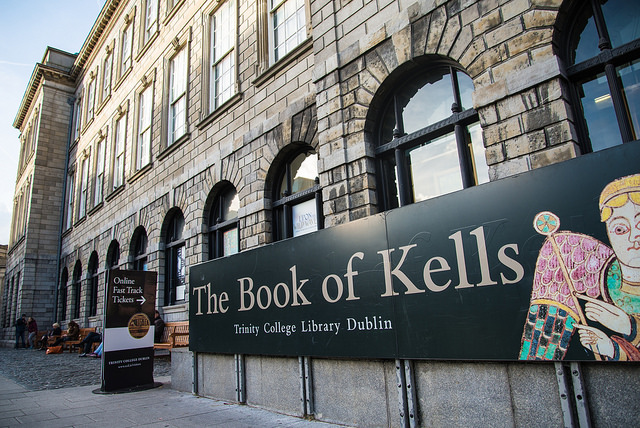For the first time, four Dark Age-era Irish manuscripts have gone on public display together in Trinity after a three-year conservation effort by the College.
Publicly unveiled by Chancellor of the University of Dublin, Mary Robinson, the four manuscripts – Codex Usserianius Primus, the Garland of Howth, Book of Dimma and the Book of Mulling – underwent a conservation programme funded by the Bank of America Merrill Lynch’s global art conservation project, which offers financial support to museums and galleries across the world.
The four manuscripts, which are rarely seen publicly, will from today be available to view at the Book of Kells exhibition on a rotational basis, offering people the chance to view the work which, after three years, have been repaired, analysed and digitised.
Together, the manuscripts, which date from early Christianity, add to Trinity’s already impressive collection of early Irish manuscripts, which includes the Book of Durrow and the Book of Armagh alongside the famous Book of Kells.
In a press statement, Trinity’s Librarian and Archivist, Helen Shenton, said: “The conservation and digitisation of the manuscripts has made them available to the world of scholarship and to the wider public audience for the first time. This national and global audience can now share in our appreciation of such unique examples of creative expression that flourished in Ireland in the early medieval period.”
“Since their creation the manuscripts have had limited accessibility and now, almost thirteen centuries later, these national treasures are finally publicly available for all to study, scrutinise and simply enjoy”, she added.
The historic books will be of significant interest to researchers around the world. The Book of Mulling, for instance, is an eighth-century pocket-gospel which contains a copy of the four Gospels and was given to Trinity in the late 18th century. The Book of Dimma, the name of which refers to a scribe of the Irish St Cronan who, according to tradition, was asked to write a gospel book in one day.
The Codex Usserianius Primus is one of the earliest-known surviving Irish manuscripts, dating to the fifth or sixth century. Despite being known to have been in Ireland from a very early date, it is unknown where it came from before Trinity acquired it in the 17th century. The Garland of Howth is another of the ancient texts. An ninth-century manuscript, it is associated with St Nessan’s monastery. It is said that the saint once threw the book at a devil on Ireland’s Eye, a small island off the coast of Howth.
The conservation project was led by Trinity’s Keeper of Preservation and Conservation, Susie Bioletti; and Head of the Department of History of Art & Architecture, Dr Rachel Moss. Their work included everything from the repair of the manuscripts to scientific analysis of the pigments used by the manuscripts’ original painters. While no contemporary Irish pigment recipes exist, a number of techniques, including X-ray fluorescence, allowed a number of the materials used in the pigments to be identified for the first time. These pigments include iron gall ink, as well as a form of arsenic and red lead – two highly toxic materials.
The books, following the conservation work, can also be viewed online. In a press statement, Bioletti and Moss said the conservation project has “ensured the preservation of these treasured manuscripts; it shed new light on our understanding of the ancient past in Ireland; and it provided digital access to enable others to make future discoveries”.
“In the same way that the manuscripts communicated to contemporary communities over 1,200 years ago, we share them with our digital communities today and invite new explorations and new ways of understanding their significance”, they added.
In a press statement, Country Executive for Ireland in Bank of America Merrill Lynch, Peter Keegan, said that their conservation project is designed “not only to conserve artworks and to shine a light on the need for preservation of cultural treasures, but also to educate communities and to convey respect for the varied cultures and traditions throughout the world”.
“Our three-year-long journey with Trinity College Dublin has been deeply rewarding, and we are indebted to their team for sharing their enthusiasm and deep knowledge of these manuscripts, regarding their history and their cultural significance”, he added.







